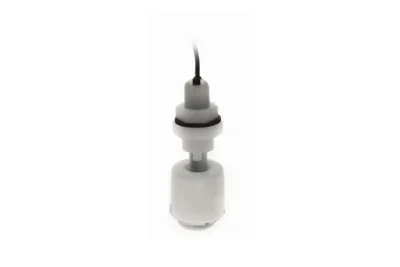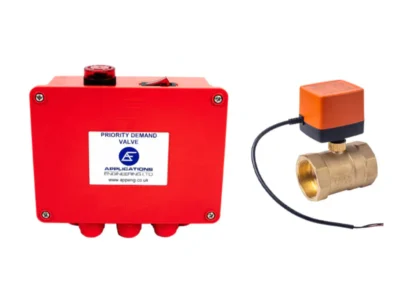Fire sprinkler valve systems are the most effective fire protection measures available today. When installed correctly and equipped with the correct high-quality components, switches, sensors, and monitoring equipment, they can control and extinguish fires effectively and, most importantly, preserve life.
There are two key types of fire sprinklers – wet and dry systems. Both have distinct characteristics and differences which is helpful to understand when choosing the right fire protection system for your property.
What Are Wet Fire Sprinkler Systems?
Wet fire sprinkler systems are the most common type of fire protection system, particularly in domestic and residential applications. The pipes are filled with water under pressure and are only installed in frost resistant areas.
In a wet system, water is continuously maintained throughout the pipework, ready for immediate release when a sprinkler head activates.
How Wet Fire Sprinkler Systems Work
The operation of wet systems is straightforward:
- Heat detection: When the temperature in a room fitted with a sprinkler reaches roughly 70°C (though it depends on the manufacturer), the sprinkler will spray water across the room and suppress the fire.
- Activation: Each sprinkler activates independently when the predetermined heat level is reached, not by smoke as is commonly believed. Thus, only the sprinklers sufficiently heated from the fire will operate.
- Water release: At 65 – 70°C, the glass bulb of the sprinkler head smashes, allowing the plug to drop and water to be released.
- Localised suppression: Sprinklers are triggered one by one where the rise in temperature occurs. They don’t all go off simultaneously, meaning water won’t be wasted in an area that’s not at risk, thus minimising damage to that room.
What Are Dry Fire Sprinkler Systems?
Dry fire sprinkler systems contain pressurised air or nitrogen gas in the pipes rather than water. Water is held back by a valve and only enters the pipes when the system activates.
These systems are designed for environments where water-filled pipes might freeze or where accidental water discharge could cause significant damage.
How Dry Fire Sprinkler Systems Work
The operation is more complex than wet systems:
- Heat detection: Like wet systems, sprinkler heads activate when exposed to sufficient heat (and not due to the presence of smoke).
- Air pressure release: When a head opens, pressurised air is released from the pipe openings.
- Valve activation: The drop in air pressure triggers the main valve to open.
- Water flow: Water then flows into the pipes and out through the activated sprinkler heads.
This process introduces a delay of typically 30-60 seconds before water discharge begins.
Table of Differences Between Wet and Dry Systems
| Aspect | Wet Systems | Dry Systems |
| Pipe contents | Pressurised water | Pressurised air |
| Response time | Immediate | 30-60 second delay |
| Complexity | Simple and reliable | More complex mechanisms (accelerators, compressors, etc.) |
| Maintenance | Lower requirements | Higher maintenance needs |
| Cost | Lower installation cost | Higher installation costs |
| Applications | Heated indoor environments | Unheated, freezing or outdoor environments |
| Domestic use | Standard choice for domestic properties | Not used in residential properties |
Uses for Dry and Wet Fire Sprinkler Systems
Applications for Wet Systems
For UK domestic properties, wet fire sprinkler systems are the clear choice. They offer several advantages for residential use:
- The immediate response of pressurised water allows for immediate containment of a fire.
- The simple mechanisms involved mean fewer potential failure points.
- Wet sprinklers typically have lower installation and long-term maintenance costs.
- Sprinklers are more efficient and use less water than hoses on fire engines.
Applications for Dry Systems
Dry systems are primarily used in commercial and industrial settings, or primarily outdoor environments that are prone to freezing conditions.
- Typical dry pipe installations include unheated warehouses, attics, garages, sheds and loading docks.
- Dry systems can also be used in water-sensitive environments that are prone to fires, such as data centres and archival storage facilities, where sensitive electronics or goods require more controlled fire suppression.
- They can also be found in certain chemical environments where immediate water discharge could create additional hazards.
Why Wet Systems Are Used as Domestic Fire Protection Standards
Domestic fire protection systems are all wet, and there are several reasons for this.
- UK homes are typically heated year-round, and not prone to freezing, unlike outdoor or certain commercial environments.
- Homeowners require an immediate, decisive, fast response of fire protection to protect lives, possessions, and property.
- The fewer overall sprinkler components involved in wet systems mean greater reliability and lower maintenance costs.
- UK domestic fire safety standards are designed around wet system capabilities.
Essential Components and Parts of Domestic Wet Systems
A typical domestic wet fire sprinkler system includes several key components that Applications Engineering can supply:
These components work together to create a reliable fire protection system that can significantly reduce fire damage and save lives.
While both wet and dry fire sprinkler systems serve important roles in fire protection, domestic applications in the UK exclusively use wet systems. Dry systems, whilst valuable for specific commercial and industrial applications where freezing or water sensitivity are concerns, simply aren’t suitable for home use.
When considering fire protection for your property, wet fire sprinkler systems offer proven, reliable protection that can control fires with minimal water usage whilst providing immediate response when every second counts.
Contact Applications Engineering today to see how our products can improve the reliability and safety of your fire sprinkler protection system.
Share This Post



